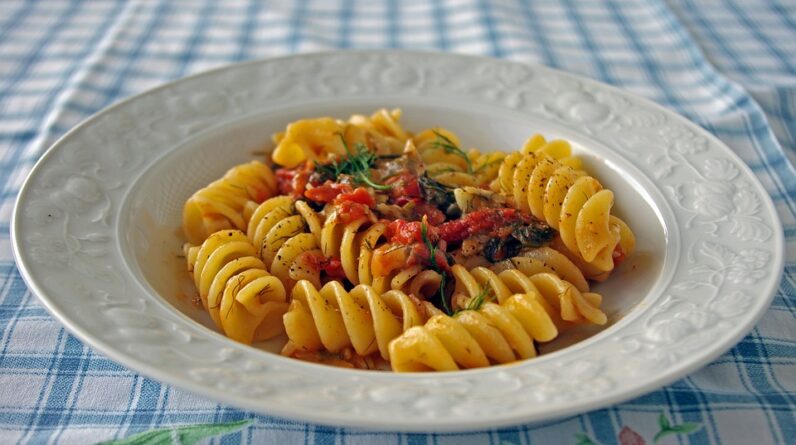Imagine a golden Italian evening, the sun casting a warm glow on cobblestone streets, laughter and chatter spilling out of dimly lit bars onto bustling piazzas. This is the iconic setting where aperitivo, one of Italy’s most delightful traditions, comes to life. But have you ever wondered how this beloved pre-dinner ritual came to be? Let’s delve into its delicious history, shall we?
Picture this: it’s the late 18th century in Turin, the air is rich with the scent of roasted coffee and the clinking of glasses. Vermouth just made its grand debut, and cafés are eager to showcase this aromatized, fortified wine to the bourgeois crowd. Casa Martini, for instance, would become notorious for its unique take on vermouth. So, in a stroke of marketing genius, they introduced the idea of having a drink early in the evening to whet one’s appetite. Thus, the concept of aperitivo was born!
Fast forward to the 1920s, and you’ve got the likes of the bright red Aperol making a splash on the scene. The now-iconic Aperol Spritz adds a pop of color and a sprightly twist to aperitivo menus across the country. It was an instant favorite among the Italians, who have always seemed to possess the magical ability to turn anything into a fashionable social affair.
But what’s truly captivating about the aperitivo is not just its boozy concoctions—it’s the way it reflects Italian life itself. It’s an art form, a societal ritual, a way of life that seduces you into the slow, luxuriant pace of Italian culture.
The innovation of aperitivo spread like wildfire, from the bustling streets of Milan down to the sun-kissed terraces of Sicily. Over time, it evolved into a sophisticated prelude to the evening meal, an essential thread in the social fabric. The simplicity of its origin story belies the aperitivo’s impact on daily life, as it effortlessly marries gustatory pleasure with social communion.
While we may thank the creators of vermouth and Aperol for igniting this tradition, it truly took on a life of its own, shaped by the people who made it a point to gather, sip, and savor the end of each day. So, when in Italy, do as the Italians do: take a moment to pause, to indulge, and to share in the communal spirit that is aperitivo. And remember, every spritz we enjoy today is a little toast to the historic Italian cities that taught us the art of unwinding with elegance and style.
Stay tuned, my fellow food enthusiasts, because next up, we’ll be nibbling our way through the tantalizing array of foods that accompany the timeless aperitivo. From salty olives to rich cheeses, prepare to awaken your taste buds to the symphony of flavors that is an integral part of the aperitivo experience. Salute!
Typical Foods and Drinks Served During Aperitivo
As the amber hue of early evening light bathes Italy’s street-side eateries and bars, the tables come alive with an array of gastronomic delights. Aperitivo time is where magic happens in the culinary world; it’s that blissful few hours where the senses are tantalized by an assortment of flavors designed to get the taste buds dancing before the main act – dinner.
To truly understand the soul of aperitivo, you must first acquaint yourself with the traditional nibbles and sips that compose this convivial pre-dinner ritual. Here’s a little primer on what to expect when you’re handed the aperitivo menu.
Firstly, let’s talk drinks. At the heart of any aperitivo is a good aperitif, the drink that awakens the stomach and prepares it for dinner. The Aperol Spritz is a beloved classic, a vibrant fusion of Prosecco, Aperol, and a splash of soda that’s as refreshing as it is a feast for the eyes. For those who fancy something a little more potent, there’s the Negroni, a punchy mix of gin, Campari, and sweet vermouth. If bitter isn’t quite your thing, you might lean towards a bubbly glass of Prosecco or a light and crisp white wine.
Now, let’s not forget the edible stars of aperitivo—the small plates that turn a simple drink into a communal feast. Grazing is the name of the game, and nothing says aperitivo quite like a tagliere, a wooden board laden with sliced cured meats like prosciutto, salami, and speck. They’re rich, they’re flavorful, and they’re perfect with a chilled drink in hand.

Alongside these meats, you can expect to find a tempting selection of cheeses. From sharp Parmesan to creamy gorgonzola, cheese plays a key role in balancing out the saltiness of the meats and the bitterness of the drinks. These are often accompanied by a bounty of olives, grilled vegetables, nuts, and small slices of focaccia or grissini (breadsticks).
But we can’t overlook the seafood offerings that often grace the aperitivo spread in coastal regions. Here, you might find marinated anchovies or bite-sized seafood salads that bring the taste of the Mediterranean straight to your palate.
For those with a taste for the more innovative, contemporary aperitivo selections might include mini portions of risotto, polenta squares with tantalizing toppings, or even bruschetta adorned with fresh tomato and basil or other delightful combinations.
Aperitivo isn’t just a prelude to dinner; it’s a moment to savor, to take pleasure in the company around you while indulging in bites and sips that embody the freshness and regional flavors of Italy. So slip into that golden hour with an open heart and a curious palate, ready to be swept away by the simple elegance of Italy’s favorite twilight tradition.
Join me next time as I wade into the nuances of aperitivo etiquette. There are a few “do’s and don’ts” to keep in mind, ensuring that you’ll be sipping and socializing like a true local. Salute!
Aperitivo Etiquette: Do’s and Don’ts

If you’re ready to dive into the world of Italian aperitivo, it’s crucial to blend in with the locals by minding your Ps and Qs. After all, social rituals come with their own set of etiquette rules, and the aperitivo is no exception. Here’s your cheat sheet to navigating this pre-dinner tradition with finesse.
Do: Embrace the art of pacing. Remember, aperitivo is about savor could lead tolizing the experience, not rushing through it. Take your time sipping your drink and nibbling on small bites. Engage in conversations, soak in the atmosphere, and let the stresses of the day melt away.
Don’t: Overindulge. While the buffet of appetizers may beckon you with its siren song, practice restraint. An aperitivo is not meant to replace dinner but to whet the appetite for the meal to come. Help yourself to a reasonable portion – this is about quality, not quantity.
Do: Dress to impress. Italians take their appearances seriously, and aperitivo hour is often seen as a chance to showcase personal style. While there’s no need to don a ball gown or three-piece suit, smart-casual attire will help you blend right in with the chic crowd.
Don’t: Assume it’s free. In many places, the price of your first drink includes access to the aperitivo spread. However, additional drinks might come at an extra cost. Be sure to understand the pricing structure to avoid any surprises on the bill.
Do: Familiarize yourself with drink options. While Aperol Spritz and Negroni are staples, each bar may have its signature aperitif. Don’t shy away from asking for recommendations; it’s a great way to discover new favorites and show appreciation for the bartender’s craft.
Don’t: Bring a large group without notice. Italian bars can be intimate spaces, and aperitivo time is popular. If you plan on enjoying the evening with a squad, make a reservation to ensure there’s space for everyone to enjoy comfortably.
Now that you’re armed with the essential dos and don’ts, you’re all set to navigate the social labyrinth of Italian aperitivo with ease. Join the ranks of the well-heeled locals, select your aperitif with confidence, and savor the symphony of tastes and textures on your plate. As the Italians say, “La vita è troppo breve per mangiare e bere male”—life is too short to eat and drink poorly. Let the aperitivo be your living example of this maxim.
Next time, we’ll explore the integral role of aperitivo in Italian social life and how this enchanting ritual extends beyond the realm of food and drink to foster connections and community. Stay hungry, my friends!
The Role of Aperitivo in Italian Social Life
The clinking of glasses, the buzz of animated conversations, and the delectable smell of assorted antipasti—welcome to the beating heart of Italian social life: the aperitivo. This cherished tradition is so much more than just a pleasant start to a meal; it’s a cornerstone of Italian culture, fostering connections and community in the most delightful way possible.
As the workday comes to a close, Italians flock to their favorite bars and cafes, not just to unwind, but to engage in a ritual that strengthens friendships, kindles new ones, and often sets the scene for business discussions outside the confines of an office. Aperitivo time is where personal and professional lives blend seamlessly, and doing so over good food and drink only enriches the experience.
Don’t be surprised to see a lively mix of patrons—from stylish youths laughing over their latest escapades to sophisticated seniors debating politics—all united by the convivial spirit of aperitivo. It’s the perfect opportunity to share stories, debate passionately, or simply bask in the pleasure of good company. And it happens every single day.
Yet, aperitivo’s significance extends beyond simple socializing. It’s a moment that symbolizes the Italian knack for living life to the fullest—the ‘dolce vita,’ if you will. In an era where our lives are dominated by the hustle and bustle, Italians remind us to pause, to cherish the moment, to appreciate those around us, and, of course, to treat ourselves to the little luxuries in life, like a well-made cocktail or a bite of artisanal cheese.

In Italy, the concept of ‘face-to-face’ communication is still highly valued, and aperitivo offers a beautiful platform for this. Eye contact, hand gestures, a warm embrace—these elements of traditional Italian communication are all on full display. In a time when our eyes are often glued to our screens, aperitivo acts as a wonderful reminder of the joy that human interaction can bring.
And it’s not just confined to friends and family. It’s common for Italians to strike up conversations with strangers during aperitivo, embracing the openness and affability that the culture is known for. Before you know it, a casual chat with the person beside you could lead to an invitation to join their table, or even a lasting friendship.
For visitors and expatriates, participating in the aperitivo scene is like receiving a golden key to local culture. It’s a chance to observe, to learn, and to immerse oneself in the social tapestry that makes Italy so enchanting. So, here’s a tip for travelers: don’t just stop by for a quick drink—linger, absorb, interact, and let the aperitivo work its magic on you.
As we raise our glasses to this beloved Italian ritual, we also acknowledge its transcendent power to bring people together. In a world where connection is increasingly commodified and fleeting, the aperitivo stands as a testament to the timeless tradition of community. Join me next, as we explore how this distinctly Italian custom has found its way into the hearts (and happy hours) of people around the globe.
Aperitivo Beyond Italy: Global Influence and Adaptations

If you’ve journeyed beyond Italy’s borders, you’ve likely noticed the sun-kissed glow of the Aperol Spritz illuminating menus worldwide. Yes, the aperitivo has sashayed its way across continents, charming everyone in its path like a gregarious Italian uncle at a family gathering. The allure of a leisurely pace, a palette of flavors, and the joy of conviviality is universal, after all.
But how has the world adapted to this slice of Italian culture? Pour yourself a glass, and let’s embark on a flavorful voyage to find out!
In cosmopolitan cities like New York, London, and Tokyo, bars and restaurants often entice crowds with aperitivo-inspired happy hours. Here, clever mixologists whip up local interpretations of the classic Italian aperitifs, and chefs pair them with international twists on the traditional nibbles. From fusion bruschetta with exotic toppings to mini-sliders with a side of Mediterranean olives, the global aperitivo scene is as eclectic as it is exciting.

In Latin America, for example, the social fabric is woven with threads similar to Italy’s, focusing on family and festivity. It’s no wonder aperitivo has been embraced here with gusto. You could find yourself sipping a Pisco-infused Spritz while nibbling on platters of ceviche and empanadas, illustrating the beautiful blend of Italian tradition and local flavors.
Meanwhile, in Australia, the laid-back lifestyle dovetails deliciously with the aperitivo culture. Rooftop bars in cities like Melbourne and Sydney buzz with talks of travel and business over sunset-lit Aperol Spritzes and antipasto platters boasting fine Aussie produce.
But it’s not just about the big cities. The aperitivo ritual has also found a home in smaller towns and communities. Here, it’s less about the glitz and more about the genuine warmth of sharing a drink and a few appetizers with good friends.
What’s remarkable is not just the adaptation of aperitivo itself, but how its spirit has become a catalyst for local reflection and creativity. Each place infuses its own character and charm into the tradition, allowing it to fit perfectly into new culinary landscapes while never losing its Italian soul.
Of course, there are etiquette tweaks that accompany these cultural exchanges. The meticulous ‘rules’ of Italy might relax a bit abroad, focusing more on inclusivity and exploration of new flavors and pairings. And while some purists may insist on adherence to the Italian ways, the essence of aperitivo—communal relaxation and enjoyment—is a flourishing global language that everyone speaks fluently.
So, next time you find yourself in a bar halfway around the world during that magical twilight hour, raise a glass. You’re not just partaking in a happy hour; you’re continuing a treasured narrative that transcends borders, connecting you with countless others who have embraced the joy of Italy’s greatest export to social life.
Embrace the global aperitivo scene with the same enthusiasm as if you were at a bustling piazza in Rome or a serene terrace in Tuscany. It’s a wonderful world of connection, enjoyment, and, of course, fabulous flavors, each glass and plate a reflection of a worldwide dance, guided by the rhythm of Italian tradition. Let’s savor every last drop!









